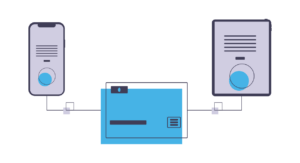An effective website is more than just an online brochure; it’s also a tool used to drive sales/leads. The conversion from a casual visitor to an engaged user is a core focus of website conversion rate optimization (CRO).
Understanding Conversion Rate Optimization (CRO)
CRO is the systematic reiterative process that aims to increase the percentage of website visitors who complete a desired action on a web page. These actions can include filling out a form, becoming customers, subscribing to a service, or any other action that contributes to your business’s goals.
Your conversion rate is calculated by dividing the number of conversions by the total number of visitors (then multiplying the result by 100 to get a percentage). Conversion rate is a key performance indicator (KPI) for any website, highlighting the effectiveness of your website’s UX and content.

The Process of Website Conversion Rate Optimization
CRO consists of several steps, including, gathering data, forming a hypothesis, testing the hypothesis, and analysis of results.
- Data Gathering: Begin with assessing the current performance of your website through analytics, heatmapping software, user feedback, and surveys. Our first step here is typically a Screaming Frog crawl with Google Analytics and Search Console APIs connected. You want to identify which pages have low conversion rates or high exit rates.
- Hypothesis Formation: Based on the data you collect, formulate hypotheses on what changes could improve performance. These could range from altering design elements, modifying content, or revising calls-to-action (CTAs).
- Testing: Implement your changes in a controlled way, typically through A/B testing. Here, you’ll create two versions of a webpage, the original (control) and a new version with the proposed changes (variant). Your site’s traffic is split between these two versions, and their performance is compared.
- Analysis: Once enough data is collected, analyze the results to see if the changes led to significant improvements. If so, you can implement the changes fully. If not, use the data to form new hypotheses and begin the cycle anew.
Examples of Website Conversion Rate Optimizations
Various optimizations can be made to improve a website’s conversion rate. Here are some practical examples:
- Optimize CTAs: Your CTA is the trigger for conversion. By making CTAs more visible, descriptive, and compelling, you increase the likelihood of a visitor taking action. For example, instead of a generic “Sign Up” button, use “Start My Free Trial”.
- Improve Site Speed: A slow-loading website is a major deterrent for users. According to Google, 53% of mobile site visitors leave a page that takes longer than three seconds to load. Optimizations like compressing images, reducing server response time, and minimizing CSS and JavaScript can greatly enhance site speed.
- Simplify Navigation: A complex or confusing navigation can deter users from exploring your website and acting on CTAs. Streamlining the navigation process with clear menus, internal linking, and a visible search bar can significantly improve user experience and conversions.
- Responsive Design: Ensure that your website is mobile-friendly. A Google study found that 61% of users said that if they didn’t find what they were looking for right away on a mobile site, they’d quickly move on to another site.
- Build Trust with Social Proof: Testimonials, reviews, and endorsements from satisfied customers can encourage new visitors to convert. A Nielsen study found that 92% of people trust recommendations from peers.
- Leverage Personalization: Using data to personalize content to specific user segments can significantly improve conversion rates. For instance, returning visitors can be shown content related to their previous purchases or interests.
- A/B Test Landing Pages: Test different versions of your landing page to see which performs best. Variations can include different headlines, images, layouts, or CTAs.
CRO is an ongoing process, not a one-time task. With continuous testing and optimization, websites can significantly improve their conversion rates, leading to higher engagement, customer satisfaction, and profitability. Remember, even small changes can lead to significant improvements in conversion rates. Keep testing, keep optimizing, and keep improving.
Schedule a Consultation
At SEO Succor, we offer CRO services to our SEO and paid media clientele, free of charge.
Contact us today to learn more about how we can improve the efficiency of your website and/or landing pages.
Schedule a complementary consultation with one of our CRO experts.


